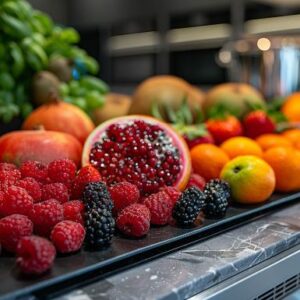Have you ever imagined mastering the ancient art of fermentation and bringing unique flavors to your table? Welcome to the world of homebrewing, where every batch is an adventure and every jar a treasure of health. In this beginner's guide, we'll explain everything you need to know to begin your journey as a fermentation master. We'll demystify the first steps, essential equipment and fundamental techniques, preparing you with confidence to create stupendous ferments in your own kitchen. Grab your bottles and get ready to launch into this fascinating journey of flavor and culture.
Where to start with home fermentation?
With the growing interest in fermented foods, both for their nutritional richness and their distinct flavor, many are wondering: what are the first steps for those who want to start fermenting at home? The first step is to understand the process. Fermentation is the transformation of sugar into acids, gases or alcohol, and serves both to preserve food and to create new delicacies.
For those new to fermentation, the second step is to acquire the basic equipment: glass jars, accurate scales, thermometers, pH strips, and possibly airlocks or cheese cloths for covering. These items are essential to ensure precision and safety during the process.
The question that naturally arises is: What basic equipment is needed to start fermenting? In addition to those already mentioned, it is crucial to sterilize all equipment before use, to avoid contamination by unwanted bacteria that could spoil your fermented product. This includes properly cleaning glass jars and utensils that will come into contact with food.
Fermenting at home not only enhances the nutritional value and flavor of food, it also improves digestive health and promotes sustainability by reducing waste. Beginners can start with simple recipes like sauerkraut, which only requires shredded cabbage, salt and time. The cabbage must be mixed with about 2% of its weight in salt for proper fermentation.
Keeping fermented vegetables in an anaerobic environment, submerged in brine, is essential to prevent mold growth. The ideal temperature for effective fermentation is between 18-22°C, and the time varies depending on the recipe, and can take from a few days to months to achieve the desired flavor.
For those just starting out, it is recommended to follow proven recipes before experimenting, and to do regular taste tests to determine when the food has reached a tangy flavor, but not sour or spoiled. Recording fermentation practices helps you achieve consistent results and learn from failed attempts. As skills develop, you can try fermenting more complex items, such as kombucha, kefir, sourdough bread, or natto.
Finally, remember that fermentation is not just a science, but also an art – join communities of fermentation enthusiasts, sharing experiences, recipes and even yeast cultures. Experimenting with different ingredients can lead to delicious, personalized fermented creations, reflecting individual expression in this equally delicious and scientific practice.
What basic techniques should I know to ferment foods?
To ensure safe fermentation of foods at home, it is essential to understand the fermentation processes. This knowledge allows you to control desirable microorganisms and minimize the risk of contamination by harmful bacteria. Salt plays a crucial role in fermentation, functioning as a food preservation agent through fermentation. Using it correctly is one of the fundamental home brewing techniques.
The recommended salt proportion in most fermentation processes is around 2% of the weight of the food to be fermented. Salt creates an environment where beneficial bacteria, such as lactobacilli, thrive and inhibit the growth of harmful bacteria. In addition, it helps maintain the crunchy texture of vegetables and intensifies the natural flavors of foods.
Basic equipment to get started includes glass jars, scales, thermometers, and pH strips. These allow you to monitor and control important variables such as temperature and acidity during fermentation. It is essential that all equipment is properly sterilized before use to avoid the introduction of unwanted bacteria.
A simple recipe for beginners is sauerkraut, which only requires sliced cabbage and salt. After mixing the cabbage with the salt, it is necessary to press the mixture to release liquids and create a brine in which the cabbage must remain completely submerged, ensuring anaerobiosis and preventing the growth of mold.
Foods in the fermentation process must be stored at stable temperatures, around 18–22 °C, to carry out fermentation. The time varies depending on the desired taste, and can take from a few days to several months.
Fermenting at home is more than a technique; It is an art supported by science. As a budding fermentation master, regularly tracking flavor and keeping a fermentation diary are practices that help you achieve consistent results and understand potential mistakes. With experience, it will be possible to explore more complex items and move forward from this first introduction to the wonderful world of fermentation. And for more information on how to start fermentation at home, be sure to check out this complete guide on the topic.
What simple fermentation recipes can I make as a beginner?
When starting out in the world of fermentation, it is common to ask yourself: what are the easy fermentation recipes to start with? A good way to start is with homemade sauerkraut and fermented yogurt – both with simple steps and impressive nutritional benefits.
Step by step to make homemade sauerkraut:
- Start by choosing fresh, firm cabbage. You will also need salt – more precisely, about 2% of the weight of the cabbage.
- Cut the cabbage into thin slices and mix with the salt in a large bowl. Massage until it starts to release liquid, which may take a few minutes.
- Transfer the cabbage and the liquid that formed to a sterilized glass jar, pressing firmly so that the cabbage is submerged in the brine. This is crucial to creating an anaerobic environment necessary for fermentation.
- Use a weight, such as a bag of salt water, to keep the cabbage submerged and place a clean towel or cheese cloth over the mouth of the jar.
- Keep the jug at the ideal room temperature (18–22°C) and out of direct sunlight.
- Taste the sauerkraut after a few days. Tangy flavor is the goal, but if it's sour or spoiled, discard it.
How to prepare fermented yogurt at home:
- Heat the milk to almost boiling, then let it cool to approximately 45°C.
- Add some yogurt with live cultures to your warm milk and stir well.
- Keep the mixture in a warm place, such as a dehydrator, oven with a light on, or covered with a blanket.
- Let it ferment for 4 to 12 hours, depending on the desired consistency. After setting, the yogurt must be refrigerated.
For those who want to delve deeper into these processes and discover other fermentation recipes, it is essential to follow the steps correctly to achieve good results. Experiment, adjust the flavors to your liking, and take note of your discoveries to hone your skills as a fermentation master.
How can I deepen my knowledge of fermentation?
What are the best sources of learning about fermentation for beginners? There are several reliable and practical sources, such as online fermentation school, which offers in-depth courses and fermentation workshops. These resources are ideal for getting started, provide a structured learning environment, and often include interactions with experienced professionals.
A recommended online course for beginners is the one offered by Fermentare, a pioneering school in the art of teaching about fermentation culture. There, you can find everything from basic courses to more advanced techniques, all aimed at those who want to become masters in the art of fermentation at home.
Fermentation transforms sugar into acids, gases or alcohol, and is a traditional method for preserving food and creating various foods and drinks. By embarking on the world of fermentation, you will not only be able to extend the shelf life of your products but also improve the nutritional value and flavor of the food.
By engaging in home fermentation, you will also be supporting your digestive health and promoting sustainability by reducing waste. Essential equipment to start fermenting at home includes glass jars, scales, thermometers, pH strips, and possibly airlocks or cheese cloths for covering.
For beginners, it is recommended to try simple fermentation recipes, such as sauerkraut, which only requires grated cabbage, salt and time. The mixture must contain about 2% by weight in salt for proper fermentation and must be kept in an anaerobic (oxygen-free) environment, submerged in brine to prevent mold growth.
Each step of the fermentation process, from sterilizing the equipment to regularly tasting the product, is a learning opportunity. Keeping a journal of your practices is an effective way to track your progress and learn from failed attempts. Over time, as your skills advance, try fermenting more complex items like kombucha, kefir, or sourdough bread.
By mastering the basics and progressing to more elaborate techniques, you'll be on your way to becoming a true fermentation master, enriching your diet and fueling your culinary creativity.
How do you know if home fermentation is successful?
You benefits of fermentation extend far beyond just preserving food. When we master the art of fermentation, we optimize nutritional value, flavor and even contribute to a more sustainable lifestyle. But countless doubts may arise when taking the first steps in this process. After all, how to guarantee the food safety in fermentation and recognize if we are on the right path?
Signs that indicate successful fermentation include the presence of bubbles, a slight acidity in the aroma, and a characteristic flavor that evolves and deepens over time. The activity of microorganisms in fermentation generates these transformations, converting sugars into acids and gases.
Did you detect anything strange? Do not panic. If there are any signs of mold, an unpleasant smell, or a slimy texture, something has probably gone wrong. These are clear indications of contamination and the batch must be discarded to avoid the risk of food poisoning. Sterilized equipment and following proven recipes are ways to prevent such problems.
As a beginner, you may want to start with simple recipes, like sauerkraut, which require few ingredients and have little room for error. Keep vegetables submerged in brine in an oxygen-free environment and monitor the temperature, keeping it between 18–22°C to allow microorganisms to do their work properly.
Regular taste testing will help identify when the food has reached its ideal flavor, as well as providing a practical understanding of how the fermentation process unfolds. It is also recommended to keep a detailed diary of fermentation practices, which can be a valuable tool for learning from not-so-successful attempts.
Finally, always pay attention to details. Fermentation is a tangible demonstration of the phrase “the devil is in the details,” but when done correctly, there is little more satisfying than enjoying your own fermented culinary creations.
What basic techniques should I know to ferment foods?
For those who want to venture into the art of fermentation at home, understanding the basic techniques is crucial. Food safety is the foundation of all fermentation processes. Ensuring that food is free from harmful bacteria starts with sterilizing equipment, which can be done through boiling or using specific solutions.
Salt plays a dynamic role in fermentation, acting as a flavor enhancer and protector against unwanted bacteria. The typical concentration for safe fermentation of vegetables is around 2% of the weight of the food. This means that for every kilogram of vegetables, around 20 grams of salt are added, which creates a hospitable environment for beneficial bacteria and inhibits those that are harmful.
Constant temperature is also vital to successful fermentation, with many processes requiring a range between 18–22°C. Sudden changes in temperature can slow down or even stop the activity of microorganisms essential for processing food.
Beginners in fermentation should stick to tried and tested recipes, reducing the chances of problems. As part of food preservation processes through fermentation, patience is a virtue; Some fermentations can take days, while others can take months.
When it comes to homebrewing, careful observation is key. Subtle bubbles, changes in texture, and the gradually developing aroma are all indications that fermentation is happening as it should. If something appears to be wrong, such as the presence of mold or an unpleasant smell, it is best to discard the attempt and start again, ensuring food safety.
To further deepen your knowledge and become a true Fermentation Master: How to Start Fermenting at Home, exploring educational resources like books, online courses, or workshops can be a valuable step. Joining fermentation communities and sharing experiences will also enrich your journey, allowing for continuous and collaborative learning.
Remembering that, as mentioned in the review, regular practice and keeping a detailed diary will help hone your skills and bring consistency to results, allowing you to soon venture into more complex ferments, each contributing their own flavor profiles. flavor and nutritional benefits to your gastronomic repertoire.
Throughout this article, we investigate the first steps, essential techniques, simple starter recipes and educational resources for starting fermentation at home, as well as the indicators of success in this exciting process. Diving into this universe of fermentation is more than a hobby; it is a journey of discovery and satisfaction. The feeling of producing fermented foods with your own hands is unique, but the true secrets of this art lie in patience and continuous improvement. Embark enthusiastically on this learning experience and become not just a practitioner, but a master of fermentation, capable of understanding each bubble as part of an alchemy that nourishes both the body and the soul.
FAQ
Common questions:
1. What are the first steps to starting fermentation at home?
The first steps to fermenting at home include understanding the fermentation process and purchasing basic equipment, such as glass jars, accurate scales, thermometers, and pH strips. It is vital to sterilize equipment to avoid contamination, and for beginners, starting with simple recipes is recommended.
2. What basic techniques are essential for safely fermenting foods?
To ensure safe fermentation, it is essential to understand the role of salt as a preservative, correctly use the proportion of 2% in the weight of the food and monitor temperature and acidity. It is also essential to sterilize the equipment before using it.
3. What are some simple fermentation recipes for beginners?
Simple fermentation recipes for beginners include sauerkraut and fermented yogurt. Sauerkraut requires shredded cabbage and salt, while yogurt requires milk and live yogurt cultures, and both need to be kept at specific temperature conditions.
4. How can I deepen my knowledge of fermentation?
To deepen your knowledge of fermentation, look for detailed courses and workshops, such as those offered by the Fermentare online fermentation school. Additionally, regular practice and participation in fermentation communities expands understanding and skill in this art.
5. How do you know if home fermentation is successful?
A successful home fermentation is indicated by the presence of bubbles, a slightly acidic aroma, and the deepening of flavor over time. Signs of contamination include mold, unpleasant smell or slimy texture. Following proven recipes and keeping equipment sterilized help ensure success.







